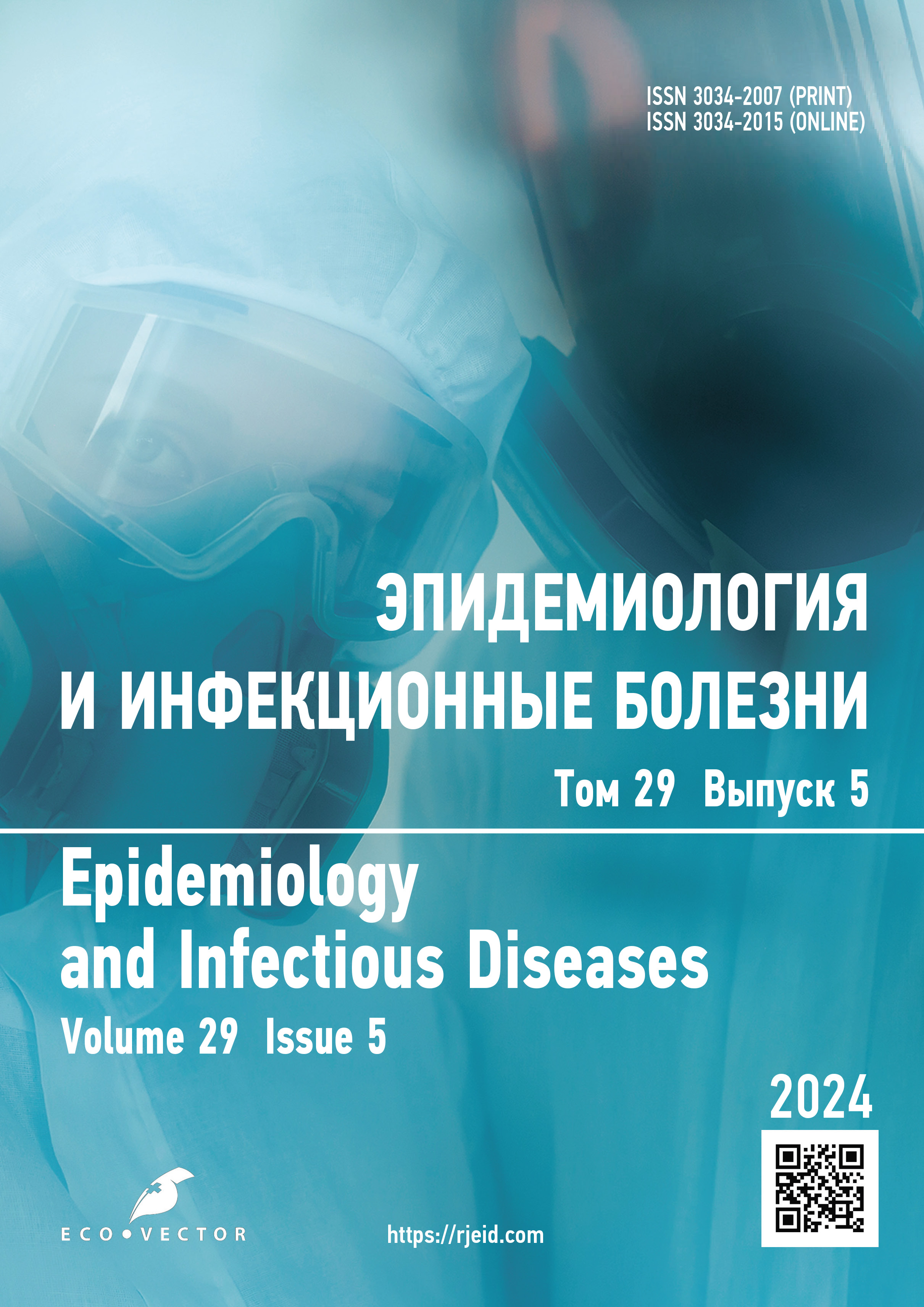Pilot project “Technologies and means of surgical hand antiseptics in medical organizations of Khanty-Mansiysk autonomous okrug — Yugra”: preliminary data
- Authors: Sisin Y.I.1, Golubkova A.A.2,3, Ezhova O.A.4,5
-
Affiliations:
- Khanty-Mansiysk State Medical Academy
- Central Research Institute of Epidemiology
- Russian Medical Academy of Continuous Professional Education
- Department of Health of the Khanty-Mansiysk Autonomous Okrug — Ugra
- Nyagan City Clinic
- Issue: Vol 29, No 5 (2024)
- Pages: 356-364
- Section: Original study articles
- Submitted: 09.09.2024
- Accepted: 17.01.2025
- Published: 15.11.2024
- URL: https://rjeid.com/1560-9529/article/view/635857
- DOI: https://doi.org/10.17816/EID635857
- ID: 635857
Cite item
Abstract
Background: Surgical site infections remain a significant concern from the inception of surgery to the present day, despite substantial advancements in medical technology. One of the critical factors in pathogen transmission is the hands of the surgeon and other individuals involved in the surgical procedure. However, contemporary research primarily focuses on hygienic rather than surgical hand antisepsis. A literature review of more than 400 sources revealed that surgical hand antisepsis was addressed in only 7 publications, mostly from a historical perspective, whereas hygienic antisepsis was discussed in 18 sources.
Aim: To evaluate the compliance of surgical hand antisepsis practices with current regulatory guidelines based on the analysis of surgical antisepsis techniques during operations, with the goal of recommending improvements.
Materials and methods: The study analyzed responses from 214 healthcare professionals directly involved in surgical interventions. The survey utilized a 25-question electronic questionnaire created by the authors and hosted on the Yandex platform. Participation was voluntary and anonymous. The study employed epidemiological (descriptive-analytical), statistical, and sociological research methods.
Results: The online survey revealed several discrepancies between the applied techniques and the recommended guidelines for surgical hand antisepsis. These discrepancies involved the use of antibacterial soap with additives for handwashing, drying hands with non-sterile wipes, failure to adhere to the recommended antiseptic application time, use of antiseptics not exclusively alcohol-based, non-compliance with the recommended duration of handwashing and antisepsis, and low adherence of staff to hand care practices. An assessment was conducted of the negative impact of certain soap and antiseptic components on hand skin condition and staff well-being. To rectify the situation, corrective measures were proposed.
Conclusions: The survey results indicate that surgical hand antisepsis protocols in some medical organizations do not fully align with recommended practices. These deviations may stem from insufficient training during medical education or inadequate supervision during routine clinical practice.
Full Text
About the authors
Yevgeniy I. Sisin
Khanty-Mansiysk State Medical Academy
Author for correspondence.
Email: evg-sisin1@yandex.ru
ORCID iD: 0000-0001-5003-1110
SPIN-code: 2422-3870
MD, Cand. Sci. (Medicine), Assistant Professor
Russian Federation, Khanty-MansiyskAlla A. Golubkova
Central Research Institute of Epidemiology; Russian Medical Academy of Continuous Professional Education
Email: allagolubkova@yandex.ru
ORCID iD: 0000-0003-4812-2165
SPIN-code: 6133-2572
MD, Dr. Sci. (Medicine), Professor
Russian Federation, Moscow; MoscowOlga A. Ezhova
Department of Health of the Khanty-Mansiysk Autonomous Okrug — Ugra; Nyagan City Clinic
Email: epid@inbox.ru
ORCID iD: 0000-0002-4277-5723
MD
Russian Federation, Khanty-Mansiysk; NyaganReferences
- Merzlikin NV, Komkova TB, Tshay VF, et al. General Surgery. Moscow: GEOTAR-Media; 2023. 1016 p. (In Russ.) doi: 10.33029/9704-7806-6-OBX-2023-1-1016 EDN: DAXUTK
- Sisin YeI, Golubkova AA, Kozlova II, Jusuf EV, et al. Surgical antisepsis in Russia: historical parallels. Epidemiology and Infectious Diseases. 2024;29(3):236–247. doi: 10.17816/EID630074 EDN: CPVUAK
- Brusina EB, Kovalishena OV, Tsigelnik AM. Healthcare-associated infections: trends and prevention prospectives. Epidemiology and Vaccinal Prevention. 2017;16(4):73–80. doi: 10.31631/2073-3046-2017-16-4-73-80 EDN: ZEPLCR
- Orlova OA, Akimkin VG. Organization epidemiogical surveillance of infections in the field of surgical intervention. Public health and life environment. 2018;(6):45–48. EDN: XTSPUL
- Akimkin VG, Tutelian AV, Orlova OA, et. al. Newsletter on infections related to medical care. Moscow: Tsentral’nyi nauchno-issledovatel’skii institut epidemiologii; 2023. 57 p. (In Russ.)
- Sadovnikov EE, Kondrikova NV, Barbarash OL, Brusina E.B. Assessing the effectiveness of risk-oriented handwashing in cardiac surgery. Epidemiology and Vaccinal Prevention. 2024;23(5):56–62. doi: 10.31631/2073-3046-2024-23-5-56-62 EDN: GIQMWG
- Izmaylov AG, Dobrokvashin SV, Volkov DE, et al. Prophylaxis of surgical site infection. Kazan Medical Journal. 2020;101(6):852–858. doi: 10.17816/KMJ2020-852 EDN: BZOIKU
- Lyubimova AV, Zueva LP, Golubkova AA, Tekhova IG. Hand hygiene of medical personnel: federal clinical recommendations. Moscow; 2014. 31 p. (In Russ.)
- WHO guidelines on hand hygiene in health care: a summary. Geneva: World Health Organization; 2013. 52 p. (In Russ.)
- Feng W, Lin S, Huang D, Huang J, et al. Surgical hand rubbing versus surgical hand scrubbing: Systematic review and meta-analysis of efficacy. Injury. 2020;51(6):1250–1257. doi: 10.1016/j.injury.2020.03.007 EDN: QVFNXH
- Gaspar GG, Menegueti MG, Lopes AER, et al. Alcohol-based surgical hand preparation: translating scientific evidence into clinical practice. Antimicrob Resist Infect Control. 2018;7:80. doi: 10.1186/s13756-018-0372-7
- Kampf G. Hand hygiene in patient care. Fundamental and Clinical Medicine. 2018;3(4):60–72. EDN: YSIABV
- Niurka MÁ, Yudalvis OC. Conocimientos, actitudes y prácticas sobre la adherencia al lavado de manos en personal de salud. Revista Cubana de Pediatría. 2020;92(2):e938. (In Spanish.)
- Lokotkova AI, Mamkeev EH, Nazarova OA, Koguashvili NE. What remains behind the scenes when choosing a skin antiseptic. Disinfection Affairs. 2023;124(2):30–36. doi: 10.35411/2076-457X-2023-2-30-36 EDN: NKNXKL
- Smirnova SS, Stagilskaya YuS, Egorov IA, Zhuikov NN. Factors determining adherence to hand antisepsis by healthcare workers during pandemic infection spread (as exemplified by COVID-19). Epidemiology and Vaccinal Prevention. 2024;23(3):47–56. doi: 10.31631/2073-3046-2024-23-3 EDN: EMCXTW
- Golubkova AA, Sisin EI, Balagutdinova SA, Soboleva LI. Contemporary disinfectology technologies in the prophylactiс of professionally-conditioned medical personal. Disinfection Affairs. 2010;(2):28–31. EDN: MTBKUR
- Bidevkina MV, Baklanova OV, Rysina TZ, et al. Comparative toxicity of certain alcohols and alcohol-based skin antiseptics. Toxicological Review. 2016;(2):19–24. EDN: VZCKPV
- Weatherly LM, Gosse JA. Triclosan exposure, transformation, and human health effects. J Toxicol Environ Health B Crit Rev. 2017;20(8):447–469. doi: 10.1080/10937404.2017.1399306
Supplementary files










